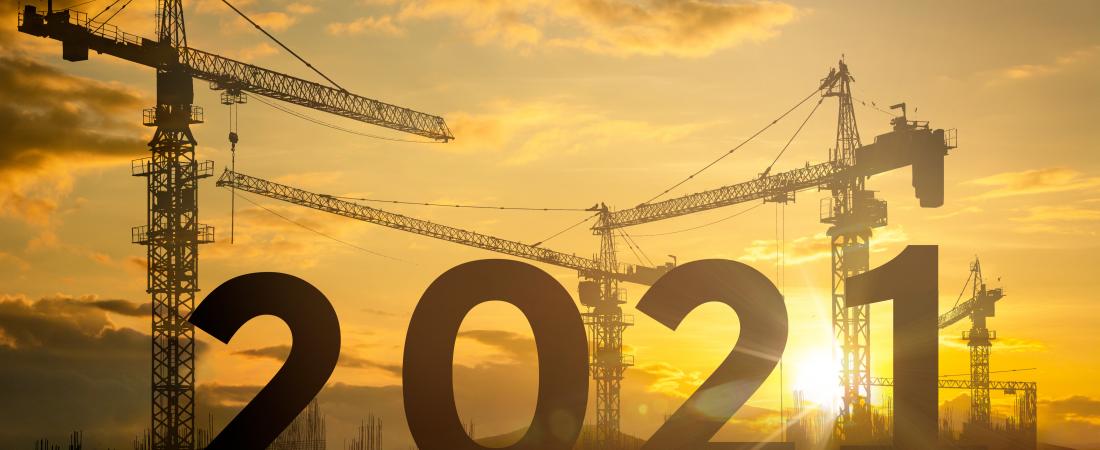
2020 has been a transformational year for the construction industry. The restrictions introduced due to the pandemic has forced the sector as a whole into digitising at a faster rate than predicted. The pandemic has also pushed companies to look at their supply chains, cash flow disruptions and safety measures on site. All of these will leave a lasting impact on the industry and the way it functions. Here are the six top trends we see on the horizon for 2021:
Safety
Ensuring safety on site has always been one of the major concerns for most construction companies. But with the measures to prevent the spread of COVID-19, the emphasis on safety has increased further. In addition to the prevailing safety measures, additional regulations have been introduced to stop the spread of the virus. These regulations include the separation of workers and stringent cleanliness protocols for equipment.
With cooperation and teamwork being the norm on site, separation is difficult to achieve in such settings. In order to reduce the risk, companies are shifting towards smaller crews that are easier to control and working in shifts to limit the number of people on site at the same time.
Additionally, stricter cleanliness and hygiene protocols can be expected.. The use of masks and hand sanitisers will be enforced to ensure the safety of everyone on site. Moreover, employees will be expected to label their tools and equipment so that they avoid sharing them with their colleagues to minimise risk of cross-contamination.
Living Materials
Living material is being developed that uses biological compounds that literally grow themselves. Once these have moved from the experimental stage, they will be mass-produced and used in the industry. The phrase ‘cast in place’ might soon be replaced by ‘grown in place’ thanks to the introduction of these living materials.
Of all the living materials being researched, self-mending concrete is one of the most exciting for the construction industry. This concrete is saturated with bacteria that bind materials around them into a new structural material. The material can grow into fissures and cracks and can be used to fill and repair them.
Remote Technology
Social distancing and work from home policies due to the pandemic have created demand for remote technology in the construction industry. Any technology that allows for manufacturing and administrative tasks to be completed remotely is bound to grow rapidly in the current market.
The use of drone technology in construction for surveying and mapping is increasing rapidly. The technology allows contractors to survey the project from above and find out what they need to know without having to visit the site. Drones can be pivotal in discovering safety issues and helping estimate the quantities of material on site. Employing drone technology saves both time and money for the construction company.
Design Technology: BIM & VDC
Design technology has been around for a while, even before the pandemic, and has been adopted widely by designers and contractors. It uses specific software to build entire buildings virtually before starting the project in the real world. This is beneficial to understand what works and what will need improvement before finalising the design, helping companies reduce time on site and manage costs.
Design technology like Building Information Modelling (BIM) is popular among architects as to build a model of their building in virtual space. They can refine designs and test ideas before committing to construction on site.
For builders, BIM is even more valuable. Often referred to by contractors as VDC (Virtual Design and Construction), the principle is the same. Imagine finding all the pitfalls of a project — the difficult connections, the coordination issues, the necessary but unaccounted for components — before a shovel of dirt is turned over. The cost savings can be incredible in the field and in the office.
3-D Printing
Three-dimensional printing is revolutionising the industry as it helps to drastically reduce job-site work density. A big nozzle is used to methodically lay concrete in vertical piles and can be directed through a programmed design. This method is already being used widely in the industry, and we can expect it to increase in popularity in 2021.
Sustainability
Sustainability will be at the forefront in 2021 with companies trying to reduce their carbon footprint. Concrete used in construction has been a significant source of CO2 emissions and is the second largest emitter of CO2 in the industry. Attempts will be made to reduce the construction industry’s carbon footprint by using low carbon cement in 2021.
